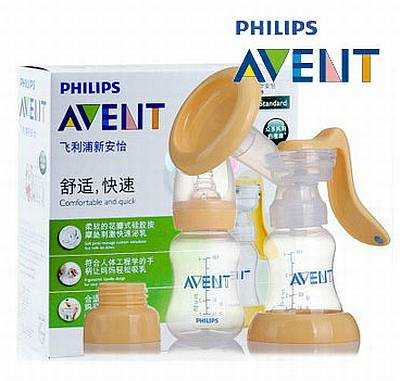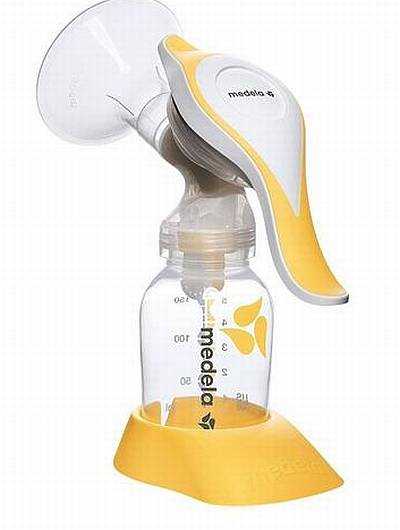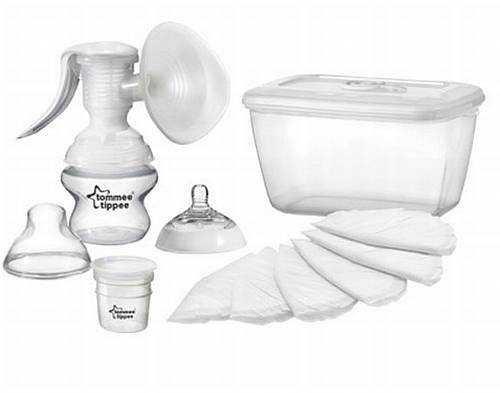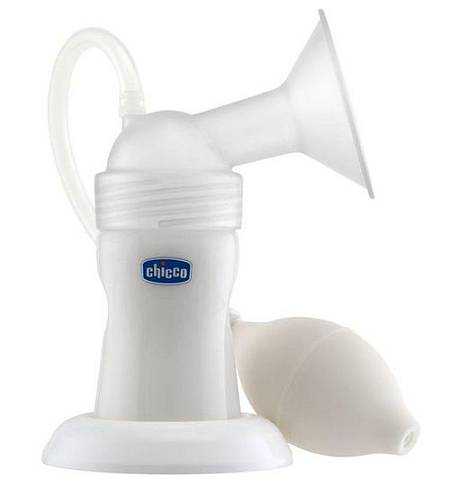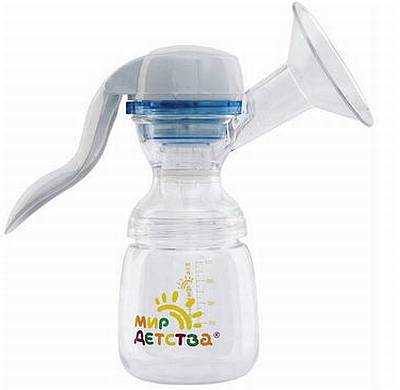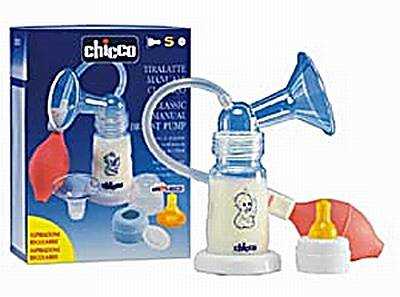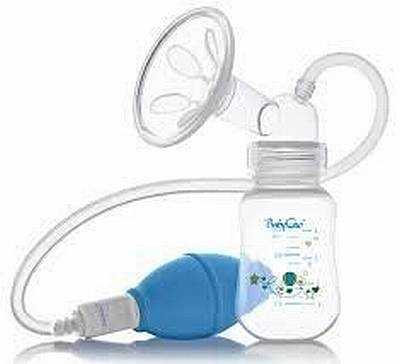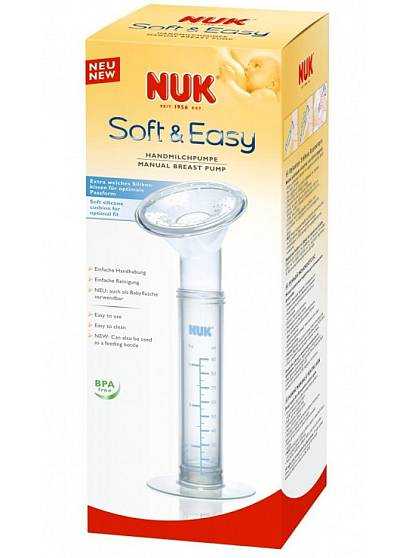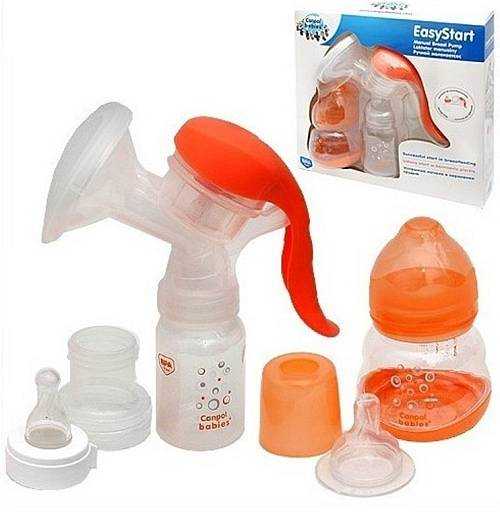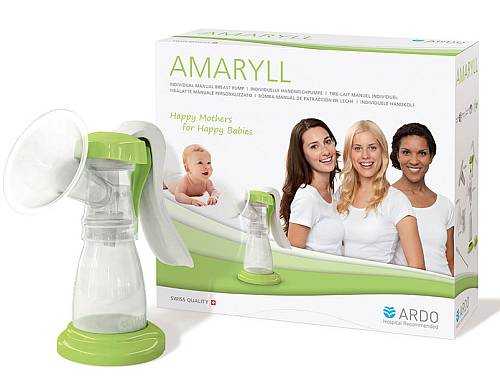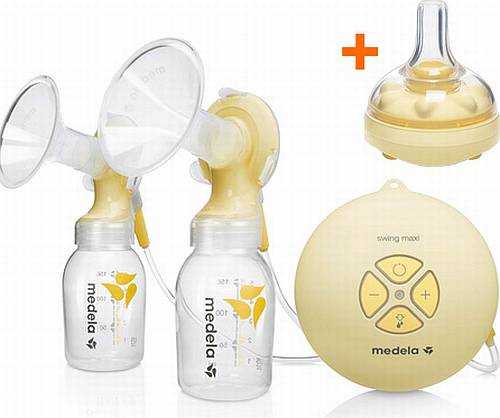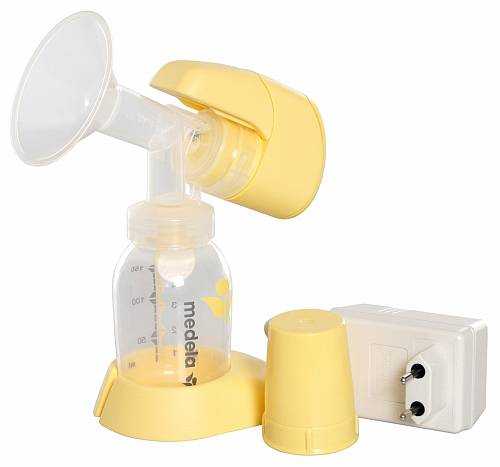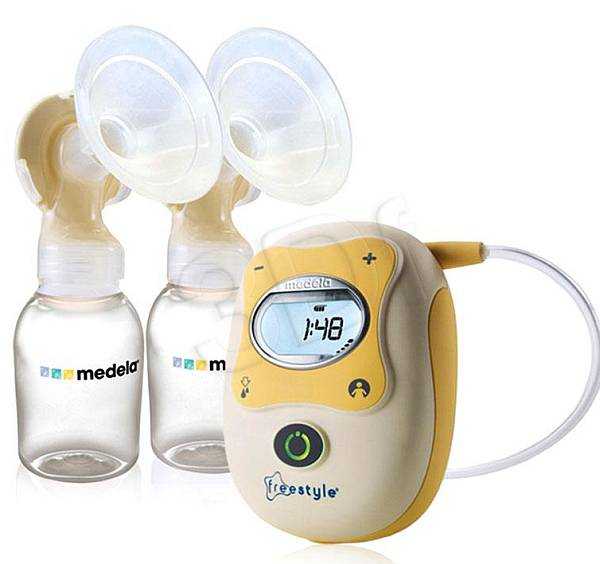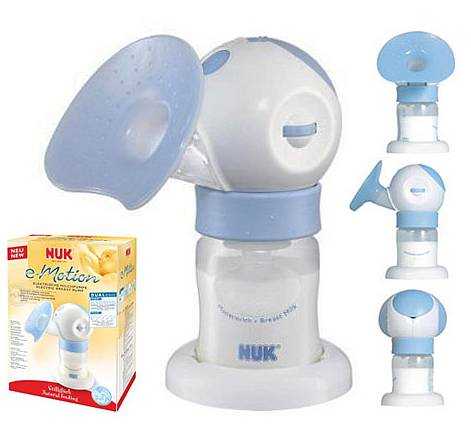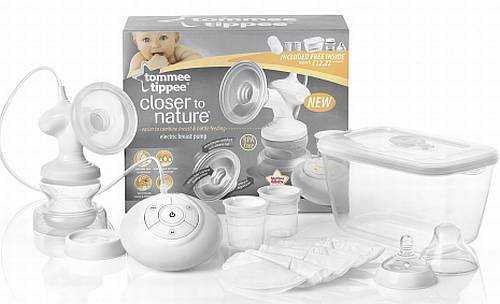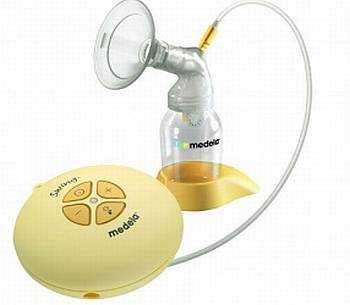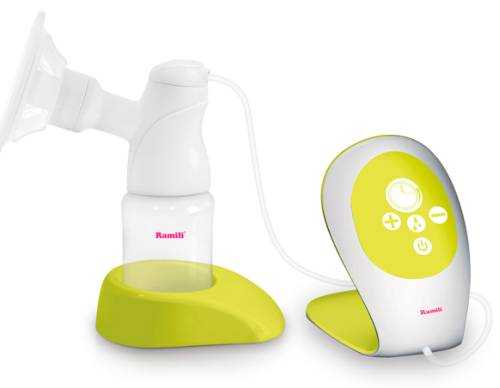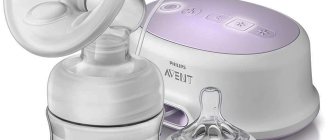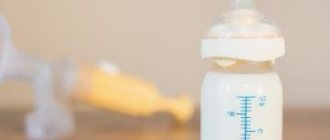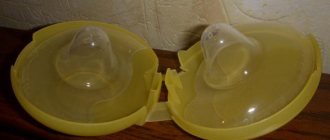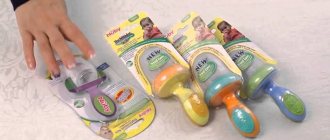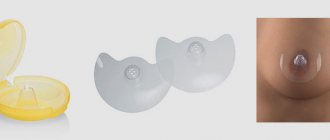The most popular among young mothers are devices manufactured by Philips, which have proven themselves to be reliable and convenient. The set includes bottles that can be used to feed your baby. To do this, unscrew the breast pump body and place the supplied nipple on the bottle. There is no need to pour milk from one container to another, therefore, there will be less hassle with sterilizing dishes. You can store breast milk in a bottle or use it as a freezer container. Shelf life in the refrigerator is up to 2 days; in the freezer, milk can be stored for 3 months without losing its beneficial properties. If you need to transport a container of milk to another location, use gel packets after cooling them in the freezer.
Manual or electric - make a choice
Manual breast pumps are recommended for those mothers who do not need to pump regularly, but only from time to time. All mechanical devices are divided into:
- Manual ones with a pump or bulb are ineffective and therefore not expensive breast pumps
- Piston or syringe - more gentle, more efficient, more convenient to use, and therefore more expensive.
| Advantages of manual breast pumps: | Flaws: |
|
|
Electric breast pumps - recommended for women who need regular pumping (a child cannot suck on his own, a working mother, during a forced refusal of feeding in order to maintain lactation, etc.)
- Pros: time saving almost 2 times compared to manual pumps, no physical effort required, efficient pumping.
- Disadvantages: they produce a monotonous hum during operation, very high price, and it is impossible to completely sterilize the device.
Electronic breast pumps - what does it mean and is there a difference from electric ones? This is some kind of marketing ploy, both types are electrical devices, only the so-called “electronic” ones are more technologically advanced, have a display and microprocessor control, for example, have a built-in memory that remembers your pumping rhythm. These are expensive devices that are usually purchased by maternity hospitals (when high performance is required), but for a woman at home it is much more profitable to rent such a breast pump.
Kinds
Philips produces the following types of Avent breast pumps - manual (mechanical) and electronic, powered by mains or batteries. Devices of the first type operate on the principle of a syringe - to express, a woman needs to press the handle at the top of the device. The intensity of work is regulated independently. The Avent mechanical breast pump quite accurately imitates a baby's sucking, and its affordable price and ease of use make it one of the most popular.
The second type of device completely automates the pumping process. Mom only needs to correctly position the nozzle on her chest and turn on the device.
The Avent electronic breast pump is two-phase. This means that there are two stages in his work - first he makes short and frequent suction movements, and then longer and more rare ones. This is how a baby sucks milk.
There are also 3 power levels, allowing you to adjust the breast pump to your needs. An electronic device costs 3–4 times more than a mechanical one.
What should you pay attention to when choosing?
So, decide how often you need it, if rarely, then you can buy a manual one, if constantly, then preferably an electric one, which can be cheaper to buy secondhand or rent. In any case, after purchasing either a new or used device, it should be thoroughly washed and sterilized before use.
When choosing a hand-held device:
- Choose a piston pump rather than a pump breast pump (which is ineffective and contributes to the development of milk stagnation)
- It is best if the breast pad is anatomical, silicone, and not plastic; it is also desirable that there are protrusions in the form of petals, they make the pumping process more comfortable
- It is much more convenient if the hand-held device comes with a bottle and nipple that fit the nozzle and after pumping you do not need to pour the milk into another feeding bottle
- Ideally, the breast pump has a 2-phase pumping system
When choosing an electrical appliance:
- It is better to give preference to a silicone nozzle with petal convexities; you should also decide on the size of the nozzle; some models come in several sizes, in some you need to buy them additionally
- It is good if the device can run on batteries, since the electrical network is not always available. Almost all modern breast pumps can be powered by batteries, but they are not included in the sales package
- There are such universal devices that can work both manually and electrically; for this, a motor is purchased separately for the manual one.
- If pumping will often be done on the road, outside the home, give preference to mobile devices, that is, lighter and more compact ones (the motor is located next to the nozzle) with a bag or container.
- To save time, you can purchase a device that pumps from both breasts at once.
- It is important what material the device is made of, preferably high quality polypropylene, without Bisphenol A
- It is also better to choose a 2-phase pumping system, in the first phase the device massages and prepares for pumping (it’s good to have several modes), the second phase quickly empties the prepared breast, and it is also desirable to have several pumping modes.
The need for a breast pump
Even women whose baby is breastfed may need this device. There may be several such situations.
- Illness of the mother in which she will not be able to breastfeed. Using a breast pump during treatment helps prevent milk stagnation and maintain lactation.
- Elimination and prevention of lactostasis. In the case when the baby cannot cope with the amount of milk, this device will effectively empty the breast.
- Lactation crisis. Every mother has a chance of developing a condition where milk production decreases. But if it is too early to finish feeding, then you can increase lactation by using a breast pump or by frequently putting the baby to the breast.

Rating of the best breast pumps
- Philips AVENT is the most popular manufacturer, which produces only 4 types of breast pumps, both pump and electric, but very high-quality models that last a very long time, so after use by mothers they are passed on and sold to each other.
- Medela is a Swiss brand in second place and produces a large selection of very high quality electric breast pumps.
- Chicco, Nuk, Canpol are also very high quality products, but not as convenient and popular as the first 2 brands.
- “World of Childhood” and “Kurnosiki” - at the lowest prices and only simple hand-made models are produced by these Russian manufacturers , with average quality and demand.
| MANUAL | ELECTRICAL | ||||
| AVENT Philips manual 330/20 | price 2800 rub. |
| Medela Freestyle electronic | 16000 |
| Medela Harmony | 2200 |
| Medela Swing Maxi | 9000 |
| Tommee Tippee Closer to Nature | 2000 |
| Philips AVENT SCF332/01 | 6800 |
| Chicco pump breast pump with bottle | 600 |
| Medela Mini Electric | 3700 |
| "World of Childhood" with milk container | 900 |
| Nuk E-motion | 3200 |
Manual breast pumps
| PUMPS | IN THE FORM OF A SYRINGE | PISTON | |
| Equipment |
| 2 cylinders
|
|
| Mechanism of action | The milk enters the container by creating a vacuum around the nipple area by pressing a bulb or pump. | Milk is extracted by creating a vacuum when the piston operates | Milk is released due to the creation of a vacuum when the piston operates |
| How to use a breast pump | The funnel is tightly applied to the areola. With one hand the breast pump is fixed to the breast, with the other hand you need to press the bulb frequently | The funnel is tightly applied to the areola. With one hand the breast pump is fixed to the breast, with the other hand you need to press the piston back and forth | The nozzle is tightly applied to the areola. With one hand you need to methodically press the lever, with the other you need to hold your chest |
| Who is it suitable for? | For mothers who do not pump and purchase a breast pump “just in case” | For mothers who rarely pump and want to save money | For mothers who plan to pump rarely, no more than 1-2 times a day |
| pros |
|
|
|
| Minuses |
|
|
|
If your choice falls on a manual breast pump, which one to choose depends on your financial capabilities and how often you will have to express. In general, all manual breast pumps are characterized by a low price, even if it is not useful, you will not regret the money spent.
Electric breast pumps
| Kinds |
Most models of electric breast pumps can operate both from mains and batteries |
| Contents (may vary) |
Additionally, the composition may include: a bag, spare bottles, milk storage containers, several breast attachments, nipples, containers for sterilization, etc. |
| Mechanism of action | Milk is released by creating a vacuum around the nipple area using a motor. |
| How to use a breast pump | The funnel is applied to the areola and suctioned to it - the nipple should be in the middle. By pressing the start button, the breast pump starts working. |
| Who is it suitable for? | For mothers planning regular pumping with minimal expenditure of their own effort and time |
| pros |
|
| Minuses |
|
Which electric breast pump should you choose if you decide to buy just such a device? Again, it all depends on the material capabilities, operating conditions, and equipment of the device.
How to start pumping?
Before using the breast pump, you should massage your breasts a little, press lightly on the breast and twist the nipple, massage the areola. This simple action triggers the production of the hormone oxytocin and stimulates the process of milk separation. The breast pump funnel should fit tightly to the breast so that there is no access to air.
The rhythm of hand movements on the piston should coincide with the rhythm of the baby's sucking movements. Start expressing by making several movements (on average 10-15) with the piston, this is necessary so that a vacuum is formed inside. If the milk does not flow well in, check whether the valve is in place and adjust it if necessary.
After using the device, all parts that are not connected to the network must be washed and sterilized.
Review of manual breast pumps
In this section, we propose to familiarize yourself with the characteristics of currently popular models of breast pumps - seeing them in comparison, the choice will be much easier. All breast pumps are made of polypropylene, most have silicone nozzles, and pumping time is 20-30 minutes. The most convenient and high-quality manual device is considered to be from Avent with a convenient milk storage system - this is the most reliable and high-quality device.
AVENT Philips manual 330/20 - the most ideal mechanical breast pump
|
Medela Harmony - delicate manual breast pump
Price 2200 rub. The most gentle breast pump with a nice design, high quality and reliability. Unlike Avent, it has a two-phase pumping system, that is, you can choose more gentle or faster pumping. Advantages:
Disadvantages: the kit does not include a nipple, you have to buy it additionally, it is not an anatomical cover for the breast shield. |
Tommee Tippee СlosertoNature - for the mobile mommyPrice 2000 rub.
Disadvantages: container for storing expressed milk is only 50 ml |
Chicco pump with bottle - ideal if you have a lot of milk
Price 600 rub. Since all pump breast pumps are ineffective and do not stimulate milk production, they can only be used if there is enough milk (not for problem feeding), they are not expensive and are available in various options on the market. But among all, Chicco is considered the most convenient, simple, with a soft bulb and an anti-colic nipple included. Advantages:
Disadvantages: only suitable for women without lactation problems |
"World of Childhood" - a good piston breast pump
Price 900 rub. When pumping is not required all the time, you can save money and buy an inexpensive piston breast pump; it is similar in design to mechanical models from the best brands, but much cheaper because it is not as durable and can break if used very intensively and frequently. Advantages:
Disadvantages: cannot be sterilized, not suitable for frequent use, no silicone insert. |
Chicco breast pump with bulb |
BABYONO 048 with pear |
Soft & Easy | |
| Manufacturer | Chicco (Italy) | BABYONO (Poland) | NUK (Germany) |
| Price | 520 rub. | 1000 rub | 1100 rub. |
| Mechanism of action | Manual, pump-action | Manual, pump-action | Manual, piston (syringe type) |
| Equipment |
|
|
|
| Capacity volume | Not provided, requires constant draining of milk | 125 ml | 90 ml |
| Sterilization | Partially, except for the pear | Partially, except for the pear | Yes |
Baby Nova |
Basic 12/205 Canpol |
Pigeon manual | |
| Manufacturer | Baby NOVA (Germany) | Canpol (Poland) | Pigeon (Japan) |
| Price | 450 rub. | 600 rub | 1800 -2200 rub. |
| Mechanism of action | Manual, piston (syringe type) | Manual, piston (with lever) | Manual, piston (with lever) |
| Equipment |
|
|
|
| Capacity volume | 90 ml | 125 ml | 125 ml |
| Sterilization | Yes | Yes | Yes |
Breast pump Canpol babies EasyStart |
Ardo Amaryll manual breast pump |
Chicco manual piston | |
| Manufacturer | Canpol (Poland) | Ardo (Switzerland) | Chicco (Italy) |
| Price | 1600 - 2000 rub. | 1600-1800 rub. | 1600-1800 rub. |
| Mechanism of action | Manual piston | Manual piston, can become electric (purchase additionally), safe plastic without BPA | Manual, with convenient suction regulator, easy to assemble |
| Equipment |
|
|
|
| Capacity volume | 150 ml | 150 ml | 150ml |
| Sterilization | Yes | Yes | Yes |
Correct use of the device
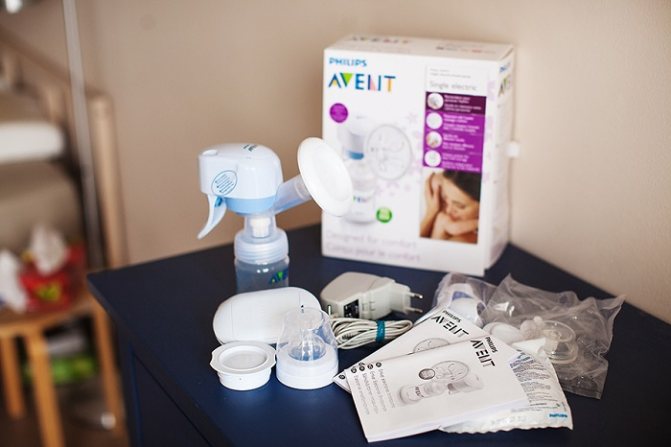
A relatively inexpensive and easy-to-use model is a manual breast pump. It is no less effective than an electric one, it is convenient to use, easy to disassemble and wash. The device has its advantages and disadvantages.
The advantages of a manual breast pump are that:
- It does not require an additional power source such as a battery or battery to operate.
- It works silently.
- The device must be controlled manually, this allows you to regulate the force of pumping and carry out the procedure absolutely painlessly.
- Hand tools can be disassembled and washed. You can learn how to properly assemble and disassemble the device from the video instructions.
The disadvantages of a mechanical device are that:
- The pumping process takes a long time. More detailed technology can be found in the video.
- In work you need to use the energy of your own hands, so fatigue occurs in your hands and it becomes difficult to use for a long time.
- The kit does not include spare parts, and the main ones may not be strong enough.
Expressing with a manual breast pump usually lasts about half an hour. This device is made of high-quality polypropylene, and the nozzles are made of soft silicone.
Expressing is comfortable thanks to the petal-shaped pad and soft funnel. The kit also includes a bottle, nipple container, lid and milk storage container. The device has a modern design.
The Avent breast pump is easy to use. If you watch a video about using different devices, you will notice that the Avent is the most convenient breast pump. To express milk, you don’t need to constantly lean forward, which is very inconvenient, especially when there were tears after childbirth and you can’t sit, you can take a comfortable position. With this device you can express milk even while reclining. When tilted, milk will not spill out of the bottle, since the device is equipped with a one-way valve-plug that allows milk to pour in, but does not allow it to pour out.
There is a soft pad on the body that stimulates milk production and makes the process of expressing easy and enjoyable. Having mastered the technology of pumping, you can understand that this process is not so difficult. For quick learning, you can watch the video.
Before use, all parts of the device must be sterilized, and each time after use, the breast pump must be disassembled and washed.
Before you start pumping, you need to wash your hands and nipples with soap and dry them. The manufacturer claims that the breast pump is comfortable to use with one hand, but some reviews say differently. Well, those who have enough strength use one hand, and those who do not, work with two.
So, the process of expressing with a manual breast pump consists of the following stages:
- It is necessary to take a comfortable position, preferably such that the body is vertical.
- Before applying the device, you need to slightly stretch the nipple with your fingers.
- You need to carefully insert the breast into the middle of the funnel, so as not to pinch the skin or rub the breast.
- All actions must be performed slowly, otherwise the nipple may be injured. You need to press the breast pump handle lightly and slowly at first and gradually increase the force, choosing the most comfortable level. If you immediately press hard, the skin on the nipple may crack and further manipulation will be very painful.
- At first, the milk will flow very slowly, a few drops at a time, and will gradually splatter.
- To successfully express milk, you need to imitate the rhythm of sucking by rhythmically pressing the handle, holding for a few seconds and pressing again.
- If milk stops coming out of your breasts, it means pumping was successful. Usually the procedure takes no more than half an hour.
After expressing, the device must be sterilized and dried again. The container with milk must be closed, indicate the time of pumping and place it in the refrigerator. You can make the process easier by combining it with feeding. You can learn more about the pumping technique using the video.
https://youtu.be/lu1OLnBFGZ4
Electric breast pumps
Before using, cleaning or sterilizing any breast pump, please read the instructions carefully as the specifications given may be subject to change by the manufacturer. All breast pumps are made of polypropylene, silicone nozzles, expressing time with an electric breast pump is 10-20 minutes.
Medela Swing Maxi - the most professional and inexpensive
Price 7500-9000 rub. Its great advantage is expressing from both mammary glands at once. It provides such a function of clinical breast pumps as protection against the penetration of milk into the motor. You can even carry it with you while pumping; the unit can be attached to your belt or hung on a cord. Advantages:
Disadvantage: high price. |
Philips AVENT SCF332/01 - the most convenient
Price 5800 - 6900 rub. A very comfortable breast pump, a woman can express even while standing or sitting, without bending forward, there is a mode for gently stimulating the arrival of milk and 3 rhythm modes, a very wide range of equipment allows you to forget about additional purchases. Advantages:
Disadvantages: noisy device and expensive compared to other single types. |
Medela Mini Electric - simple and compact
Price 3300-3700 rub. This breast pump is distinguished by the fact that the motor is small and located directly on the suction funnel, that is, there are no unnecessary wires and space is saved, and it is also affordable. Advantages:
Disadvantage: Quite noisy |
Electronic Medela Freestyle - the most effective
Price 16,000 rub. This is the most productive of home appliances; at the same time, it is compact and lightweight; milk is expressed very quickly. The high cost stops many women from buying it, but no one regrets purchasing it. The display shows process characteristics with backlighting at night. Pros:
Disadvantage: high price |
Nuk E-motion - very good among inexpensive ones
Price 3300 rub. The two-phase breast pump system helps to bring pumping closer to the baby’s natural sucking and smoothly regulates the pace of work. Just like Medela, the motor is located on the device, which makes it compact and mobile. Advantages:
Disadvantage: the pumping speed control (wheel) is inconvenient |
Tommee tippee | Chicco |
BabyOno No. 051 | |
| Manufacturer | Tommee tippee (England) | Chicco (Italy) | BabyOno (Poland) |
| Price | 5000 - 5500 rub. | 2000 rub | 2000 rub |
| Mechanism of action | Electric (from mains and batteries) | Electric (from mains and batteries) | Electric with manual air exhaust system |
| Equipment |
|
|
|
| Expression modes | 4 | 1 | 1 |
| Capacity volume | 150 ml | 120 ml | 150 ml |
| Sterilization | Yes, except power supply | Yes, except the engine | Yes, except the motor |
Medela Swing |
Ramili Single Electric SE300 |
Ramili Single Electric S150 | |
| Manufacturer | Medela (Switzerland) | Ramili (UK) | Ramili (UK) |
| Price | 6500-6800 rub. | 4500-4800 rub. | 3500-4000 rub. |
| Mechanism of action | Electronic, both mains and battery powered, lightweight, silent, two-phase pumping | Electronic, BPA free, spill proof, mode display | Electric - 7 modes, both from the mains and from batteries |
| Equipment |
|
|
|
| Capacity volume | 150 ml | 200ml | 200 ml |
| Sterilization | Yes, except power supply | Yes, except power supply | Yes, except power supply |
How to use a manual breast pump?
They are the most popular because they are affordable. To use a breast pump correctly and not injure your breasts again, you should follow some rules:
- Before the first use after purchase, all parts should be washed, sterilized, and dried.
- Immediately before pumping, wash your hands with soap and your breasts with just water.
- If you have time, you can make a warm compress for the breasts, which will warm them up and relax them, which will facilitate the process of milk secretion.
- The funnel of any device is applied so that the nipple is in its center; if possible in this model, then the pressure of the manual device should be adjusted in order to avoid painful sensations.
- Prepare a container for milk if your breast pump does not contain a baby bottle. Prepare a clean device.
- For faster pumping and breast development, you can first try expressing a little by hand (see how to properly express milk by hand).
- Sit in a comfortable position, preferably with your elbows on a pillow or the back of a chair, install the breast pump as shown in the instructions, placing the silicone nozzle on the center of your chest.
- In the first minutes, milk will be released in drops, then in streams. The lever or pear should be squeezed rhythmically until the end.
- If painful sensations appear, you need to take a break and rub your chest with your hands. However, if you pump correctly, there should be no pain, which means the breast shield is not installed successfully and its position should be changed.
- Alternate breasts, pump on one breast for a few minutes, then move on to the other.
- After completing the procedure, wipe your breasts with a damp towel, wash all parts of the breast pump, sterilize, and dry.
How to sterilize a breast pump?
The expediency of sterilization is clear to everyone - everything that comes into contact with sterile breast milk must also be sterile. It is recommended to wash and sterilize the breast pump immediately after use. This way, you will be fully prepared for your next pumping session. If you postpone this important event until later, there is a chance to completely forget about sterilization. If you treat your device immediately before pumping, you will waste valuable time.
So, before sterilization, all parts must be washed. The instructions for the breast pump should indicate which parts can be sterilized and which cannot. For sterilization, you can use a standard sterilizer, a double boiler or a pan of boiling water. Sterilization time (or boiling) is 5-10 minutes. After sterilization, the breast pump and all components are dried and folded for storage.
Author:
Sabuk Tatyana Leonidovna hygienist, epidemiologist
